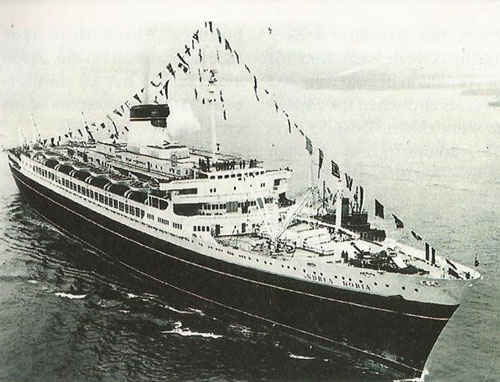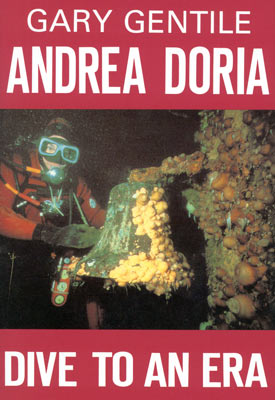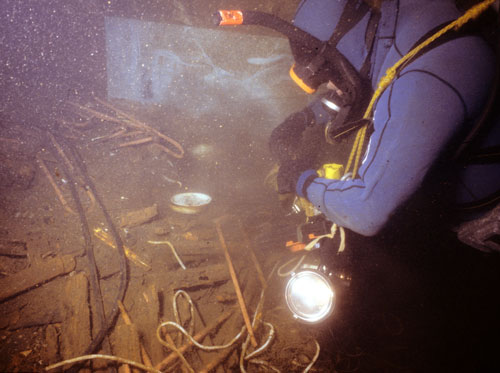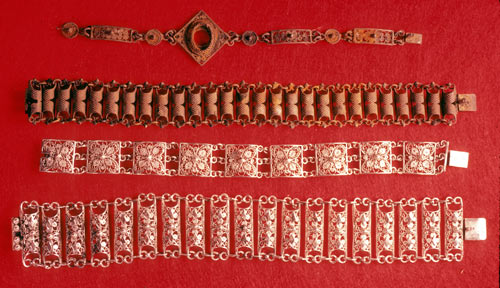Part II – What Next Grand Dame? Andrea Doria In Hospice
John Moyer looks back with fond memories on his extraordinary recovery of the Gambone sculptures. He knows he’ll never enter the Wintergarden Lounge again, nor will anyone else. The lounge, like the rest of the Andrea Doria, is buried beneath crumbled partitions, fallen bulkheads and twisted stairwells.

Andrea Doria was the flagship for the Italia Line.
Credit: Ellsworth Boyd Archives
Two submersible surveys—one in 2014 by scientists from the University of New Hampshire—and the other in 2016 by Ocean Gate, Inc. of Everett, Washington, came to a not too surprising conclusion: “Rapid breakdown all over.” Detailed images of the 29,000-ton vessel reveal most of the superstructure collapsing including the upper decks. The swimming pool is encased in debris and the bow has broken off forward of the fallen bridge. The bow is one of the few places with definition. A large crack has appeared at the stern, but offers no entry gaps. As the ship decays, familiar guideposts divers once used to navigate around it are disappearing. The old gal, known as the Mount Everest of Diving, is barely recognizable for what she was in her heyday. Times have taken its toll. Like a patient with little hope, the once robust lady is in a hospice state. Renowned East Coast diver Evelyn Dudas of West Chester, Pennsylvania–the first woman to dive the Andrea Doria—summed it up succinctly when she said, “I’m happy I visited it in the good old days…there’s not much left now.”

One of the best books of many written about the Andrea Doria
Credit: Gary Gentile
Many books have captured the saga of the Andrea Doria including Out of the Fog, Collision Course, Deep Descent and Lost Liners. One of the best is Gary Gentile’s Andrea Doria: Dive to an Era. A native of Philadelphia, now residing in Jim Thorpe, Pennsylvania, Gentile has logged more than 100 dives to the wreck. He, along with Bill Nagle, Tom Packer and other dive team members recovered the ship’s bell. Packer and the anemone-encrusted bell are featured on the cover of the book.

Searching for goodies in the gift shop in the First class Foyer
Credit: Gary Gentile

Italian hand-crafted bracelets recovered from the gift shop
Credit: Gary Gentile
Author: Ellsworth Boyd
Ellsworth Boyd, Professor Emeritus, College of Education, Towson University, Towson, Maryland, pursues an avocation of diving and writing. He has published articles and photo’s in every major dive magazine in the US., Canada, and half a dozen foreign countries. An authority on shipwrecks, Ellsworth has received thousands of letters and e-mails from divers throughout the world who responded to his Wreck Facts column in Sport Diver Magazine. When he’s not writing, or diving, Ellsworth appears as a featured speaker at maritime symposiums in Los Angeles, Houston, Chicago, Ft. Lauderdale, New York and Philadelphia. “Romance & Mystery: Sunken Treasures of the Lost Galleons,” is one of his most popular talks. A pioneer in the sport, Ellsworth was inducted into the International Legends of Diving in 2013.
4 Comments
Submit a Comment
All Rights Reserved © | National Underwater and Marine Agency
All Rights Reserved © | National Underwater and Marine Agency
Web Design by Floyd Dog Design
Web Design by Floyd Dog Design

Interesting article and beautiful photos! It’s too bad the ship is falling apart so badly. Was Gary able to keep the artifacts he found or did he have to turn them in to someone? Sounds like there were some amazing finds!
I’m glad you liked the article.It was interesting to write about the Grand Old Dame. Yes, Gary and the other divers throughout the years kept their artifacts. The Andrea Doria is in international waters. Any wreck from the shoreline to three miles out belongs to the state whose shores it’s off of. The Andrea Doria is 50 miles offshore. Divers have donated some of their artifacts to museums.
Very interesting article.
I find this ship fascinating as Titanic. I’ve been trying to find some good photos of the inside to do some paintings, I’m working on some from Titanic right now. Back in the 80’s I was introduced to this one seeing that documentary on the safe they recovered. I hope I can find some books on this ship with great photos of the inside to work from. I don’t have many.